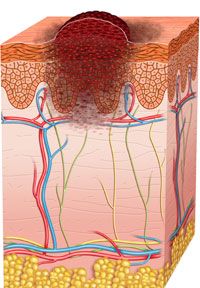Vemurafenib/ Cobimetinib Combination Demonstrates Efficacy in Melanoma
The combination of vemurafenib with the investigational MEK inhibitor cobimetinib demonstrated a 13.7-month median PFS and an ORR of 87% in treatment-naïve patients with BRAFV600 mutation-positive metastatic melanoma.
melanoma

The combination of the BRAF inhibitor vemurafenib (Zelboraf) with the investigational MEK inhibitor cobimetinib (GDC-0973) demonstrated a 13.7-month median progression-free survival (PFS) and an overall response rate (ORR) of 87% in treatment-naïve patients withBRAFV600mutation-positive metastatic melanoma, according to phase Ib results presented at the 10th European Association of Dermato Oncology Congress in Vilnius, Lithuania.
The large open-label phase Ib trial, known as BRIM7, enrolled 66 vemurafenib-refractory patients and 63 BRAF inhibitor-naïve patients withBRAFV600mutation-positive metastatic melanoma. In the patients who progressed on vemurafenib, the median PFS was 2.8 months and the ORR was 15%. The median overall survival (OS) for the BRAF inhibitor-naïve patients had not been reached after a median 12.7-month follow-up. The 1-year survival estimate was 83%. Among vemurafenib-refractory patients, median OS was 8.3 months with an estimated 1-year survival of 32%.
The FDA approved single-agent vemurafenib in August 2011 for patients with unresectable or metastatic melanoma with theBRAFV600Emutation. This decision was based on an improvement in PFS and OS for vemurafenib compared with the chemotherapy dacarbazine. Median PFS with vemurafenib was 5.3 months compared with 1.6 months with dacarbazine. At the time of the approval, median OS was not reached for vemurafenib compared to a median of 7.9 months with dacarbazine. At 6 months, OS rate was 84% with vemurafenib compared with 64% with dacarbazine.
In 2012, Roche launched a phase III trial to compare cobimetinib in combination with vemurafenib to single-agent vemurafenib in previously untreatedBRAFV600mutation-positive patients with unresectable locally advanced or metastatic melanoma. Results from this study, labeled coBRIM, are expected later this year.
“These encouraging final data from the phase Ib BRIM7 study are an important step in understanding the potential role of combining the MEK inhibitor cobimetinib and the BRAF inhibitor Zelboraf to treat metastatic melanoma,” Sandra Horning, MD, the head of Global Product Development and chief medical officer at Roche, said in a press release. “In combining these molecules we aim to overcome resistance to BRAF inhibition and maximize potential patient benefit, and we look forward to the results of the ongoing phase III coBRIM trial.”
The primary endpoint of the BRIM7 study focused on safety, tolerability, and the identification of an optimal dose. The secondary outcome measures focused on efficacy. The study identified cobimetinib at 60 mg daily for 21 days followed by 7 days of rest with continuous vemurafenib twice daily at 960 mg as the optimal dose. This dose was used in the coBRIM study.
In the BRAF inhibitor-naïve arm of the BRIM7 study, 78% of patients experienced a partial response (PR), 10% achieved a complete response (CR), and 10% reached stable disease (disease control rate [DCR] = 97%). In patients refractory to vemurafenib, ORR was 15% and 42% of patients achieved stable disease (DCR = 57%).
Across all 129 treated patients, the most common all-grade adverse events were diarrhea (64%), non-acneiform rash (60%), fatigue (48%), nausea (45%), liver laboratory test abnormality (40%), and photosensitivity/sunburn (40%). The most frequently reported grade ≥3 adverse events were liver laboratory test abnormality (11%), cutaneous squamous cell carcinoma (9%), non-acneiform rash (8%), anemia (7%), joint pain (6%), fatigue (5%), and diarrhea (5%).
“Building on the previous data from the BRIM7 trial, these final results provide encouraging signs of clinical activity in BRAF inhibitor-naïve patients with the combination of cobimetinib and vemurafenib,” Michael M. Morrissey, PhD, president and chief executive officer of Exelixis, said in a release. “People with this disease still urgently need improved treatment options, and we look forward to the top-line data from coBRIM, the ongoing phase III pivotal trial, anticipated later this year.”
The dual inhibition of both MEK and BRAF is thought to circumvent treatment resistance that commonly occurs with single-agent therapy. Moreover, this combination is thought to reduce the incidence of secondary skin cancers associated with BRAF-targeted monotherapy.
In January 2014, the FDA approved the combination of the BRAF inhibitor dabrafenib (Tafinlar) and the MEK inhibitor trametinib (Mekinist) for patients with unresectable or metastatic melanoma who harbor aBRAF V600EorV600K
Response Time and BRAF Status Factor Into IO Selection for Melanoma
January 29th 2025During a Case-Based Roundtable® event, Thach-Giao Truong, MD, discussed how data from the CheckMate-067 and RELATIVITY-047 affect their choice of therapy for metastatic melanoma in the first article of a 2-part series.
Read More